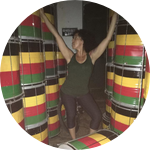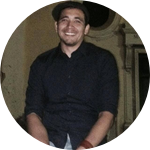About This Project
Our search is for an effective anti-viral. A few carbohydrate binding proteins (lectins) are powerful antivirals. We designed a synthetic gene. The goal of our first experiment is to place this into an e-coli expression plasmid vector, transform it into competent cells, grow it on agar and induce, then purify it. Will we be able to come up with the active substance for a microbicide? This initial experiment will lead us closer to finding an answer to that question.
Ask the Scientists
Join The DiscussionWhat is the context of this research?
Having witnessed the suffering caused by certain viruses (I lost my younger sister to HIV), I am motivated to reduce this suffering. In my study of molecular biology, I discovered research on lectins as entry inhibitor anti-virals (which keep the virus out of the cell and if the virus can't enter a cell, it has no means to replicate). Here are links to a few of the papers on this research:
http://www.actabp.pl/pdf/4_2006/617.pdf
http://journals.plos.org/plosone/article?id=10.137...
http://www.sciencedirect.com/science/article/pii/S...
https://www.researchgate.net/publication/283005708...
What is the significance of this project?
Up until now, more than 39 million people worldwide have lost their lives to HIV. Every year, with increased prevention education and availability of antiretroviral therapy, the death toll is going down.
Though progress is being made in the fight against HIV, the devastating effects of the virus remain a major health problem and cause of human suffering.
In 1976 the first Ebola virus outbreak was reported in Africa with the virus infecting 318 people out of which there were only 38 survivors. In March 2014 there was an outbreak of Ebola in Sub Saharan West Africa that claimed 11,173 lives as of June 2015
Hepatitus C virus infects more than 170 million people worldwide
The lethal SARS virus broke out in 2003
One small step towards developing effective antivirals able to stop these viruses.
What are the goals of the project?
We designed a synthetic gene, VRBNCR-01. The goal of our first experiment is to see if we can successfully get this gene into an e-coli expression plasmid, transform it into competent cells, grow on agar and induce it to express the small protein, or peptide, we call LBOUNCER and then to purify it. We are preparing now and will start working in the lab this summer (if we meet our goal here).
Budget
With any molecular biology experiment, it is typical to repeat it as something will not usually work the first time, so debugging and repetition is needed. The results need to be analyzed for consistency. Can we follow the same protocol and get the same results each time? How can we refine and improve the process? The budget takes this into consideration, i.e. having enough time in the lab and enough materials to work with. We anticipate working diligently over a period of 6 months.
Endorsed by
Meet the Team
Edwin Schenderlein
Hmmm...I don't seem to have a biographer. So I think I must put something autobiographical here. I'll keep it concise and relevant. In 2014 I went to a meetup at Berkeley Biolabs, an incubator/biohacker space. There in the lab someone put a pipette in my hand and showed me how to use it. This was my introduction to molecular biology and I found it a fascinating area to study. I am one who enjoys doing wetwork. Since then I have been attending many meetups, and have been fortunate to meet highly qualified scientists who have allowed me to work with them in the lab and have shown me the way when I am lost in the molecular forest. My eternal gratitude is theirs, and I would not be planning this experiment if it were not for their generosity and patience.
Celena Carrillo
Education
B.A., Integrative Biology, University of California, Berkeley, 2001
Research
Over 10 years of experience in assay development and systems integration for automated bio-detection systems. At Lawrence Livermore National Laboratory served as technical lead in the Chemical and Biological National Security Program in the Bioassays Group and played a lead role in the development efforts for several federally funded projects focused on automated multiplexed assay detection for both human and animal pathogens.
Positions and Honors
Biomedical Research Scientist, October 2004 to present, Physical Life Sciences Directorate, Biosciences and Biotechnology Division, Lawrence Livermore National Laboratory
Microbiologist, August 2001 – October 2004, Energy and Environment Directorate, Yucca Mountain and Repository Science Program, Lawrence Livermore National Laboratory
Global Security Principal Directorate Program Award, Lawrence Livermore National Laboratory, 2009
Engineering Directorate Program Award, Lawrence Livermore National Laboratory, 2009
Global Security Principal Directorate Program Award, Lawrence Livermore National Laboratory, 2008
Non-Proliferation Homeland and International Security Directorate Program Award, Lawrence Livermore National Laboratory, 2007
Energy and Environment Directorate Program Award, Lawrence Livermore National Laboratory, 2003
Contribution to Science
The qPCR and multiplexed assays described can be used for the simultaneous detection and differentiation of multiple DNA and RNA viruses in a single sample with the ultimate benefit of savings in both time and money, compared to traditional single tests for infectious agents. In an event of a disease outbreak, this assay approach can also be adapted to high throughput processing using robotic sample handling and could enhance preparedness and response capabilities of both state and federal diagnostic laboratories.
List of published papers on request.
Sean Greenwood
Hi, I'm Sean. I am an entrepreneur. Learning and working on his first Bio-tech start up. My interests are varied and complicated. Including genetic engineering, horticulture, evolution, bacteria and viruses, CRISPR , bio 3d printing, bio-drones, tissue regeneration, artificial species/life, Gmos , selective breeding, how to grow food, designing bio mechanical exoskeletons/growing spaceships, bio batteries, building biospheres.
Claudia Sanchez
I am an advisor for this great team. I am a scientist (formerly some kind of a lab rat... until I had my baby) with around 20 years of experience in microbiology. I have worked with entero bacterias, enteroviruses, flaviviruses, alphaviruses and new emergent pathogens. I have a PhD in biochemistry and right now I work at UCSF. I met Edwin in a meetup at Berkeley Biolabs, where I learned for the first time about biohackers, and discovered a completely new world for me: people from different backgrounds, and some of them with almost no previous training in science, doing science!
Edwin is very interested and passionate about making science available for everybody. He has worked very hard to develop this idea. I have been questioning and challenging his ideas all the time, I wonder how he still talks to me.
Additional Information
What this experiment is not!
1. We are not experimenting with any viruses during this experiment. In vitro, animal and clinical studies are outside the scope of this project. If we are able to produce our peptide consistently with high purity, we will look into future experiments or partnerships to explore the pharmacological actions it may exhibit.
2. Will this prevent or cure all viruses? No. It may not have any antiviral action at all. However, reading papers by other researchers encourages us that it may inhibit several viruses of different classes, which is interesting.
3. We are not offering any promotional gifts to donors. What we are offering, and it is there for you if you donate or not, is a link to our blog, where you will find many links to cutting edge science as well as our own research as it takes shape. Think of it as an invitation to a join our journey of discovery. http://nenufarmolecules.blogspot.com/
Project Backers
- 19Backers
- 11%Funded
- $677Total Donations
- $35.63Average Donation







